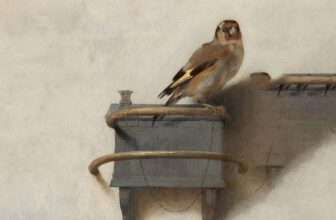
A Cafe Under the Stars: Café Terrace at Night by Vincent van Gogh
On a quiet cobblestone street in the southern French town of Arles, a warm amber light spills from a café and casts an inviting glow onto the terrace. Overhead, a sky of deep indigo sparkles with stars, captured in brushstrokes that seem to shimmer and move. The scene is tranquil yet alive, simple yet steeped in emotion. This is Café Terrace at Night, one of Vincent van Gogh’s most beloved masterpieces, painted in September 1888.
More than just an image of an outdoor café, this painting is a window into Van Gogh’s emotional world, his technical brilliance, and his unique vision. It has captivated audiences for more than a century, earning a place not only in art history but also in the hearts of millions.
What Makes Café Terrace at Night Special?
There is something deeply enchanting about Café Terrace at Night. It stands out among Van Gogh’s oeuvre and within the broader history of art for several reasons.
Firstly, it marks a turning point in Van Gogh’s style and emotional expression. The work was painted shortly after he moved to Arles in the south of France, a place he hoped would bring him healing, light, and inspiration. Unlike the dark palettes of his earlier Dutch period, Café Terrace at Night is bursting with color, especially yellows, blues, and greens, and reflects his evolving use of expressive color rather than realistic representation.
What makes the piece especially compelling is its atmosphere. Though the scene is unpopulated by anyone we can clearly identify (the figures are mere silhouettes), it feels warm, human, and welcoming. The café glows like a hearth in the night. The way the street recedes into the background creates a sense of place and movement. And then there’s the sky, filled with Van Gogh’s characteristic swirling stars, suggesting something eternal watching over this fleeting moment.
Interestingly, Van Gogh never signed this painting, possibly because he considered it part of a larger experiment or moment of transition. And yet, despite the absence of a signature, the painting is unmistakably his.
Where is Café Terrace at Night Now?
Today, Café Terrace at Night is housed in the Kröller-Müller Museum in Otterlo, Netherlands. This museum holds the second-largest collection of Van Gogh’s works (after the Van Gogh Museum in Amsterdam), and it provides a serene, almost spiritual setting in which to view the piece.
Though many fans assume this painting is in France because of its subject and origin, it found its way back to the Netherlands after Van Gogh’s death, through collectors and institutions that recognized its importance. Seeing it in person at the Kröller-Müller Museum is a moving experience, especially because the museum is located in a peaceful natural park, echoing the quiet charm of the painting itself.
What Kind of Painting Is It?
Café Terrace at Night is an oil painting on canvas, measuring 80.7 cm × 65.3 cm (roughly 31.8 in × 25.7 in). It belongs to the Post-Impressionist movement, a style that grew from Impressionism but focused more on symbolic content, formal order, and structure.
While the Impressionists painted what they saw in fleeting moments of light and atmosphere, Van Gogh was more concerned with what he felt. In this sense, Café Terrace at Night transcends simple visual representation, it becomes a canvas of inner light and mood.
The painting is also notable for its pioneering depiction of a night scene without using black. Van Gogh wrote to his sister about this painting, saying, “I have a tremendous need for, shall I say the word, for religion, so I go outside at night to paint the stars.” This spiritual yearning is clear in his choice to fill the sky not with darkness but with life, movement, and color.
Techniques Behind the Magic
Van Gogh’s technique in Café Terrace at Night is both technically refined and emotionally intuitive. Some of the techniques that stand out include:
1. Impasto
This is the technique of applying paint thickly so that brushstrokes are visible and almost sculptural. Van Gogh mastered impasto, and in this painting, it gives the scene texture and depth. The cobblestones, the glow of the lights, and the stars in the sky all gain a tactile quality that invites the viewer in.
2. Directional Brushwork
Van Gogh used deliberate brushstrokes to lead the viewer’s eye through the composition. Look closely at the lines of the café awning, the vertical columns, and the angled tables, they all converge to draw attention toward the back of the scene, adding depth and movement.
3. Contrasting Colors
Color contrast plays a crucial role in the painting. Van Gogh contrasts warm yellows and oranges of the café with the cool blues and purples of the night sky and surrounding buildings. This creates a visual harmony that balances intimacy with vastness.
4. Perspective
The use of one-point perspective gives the painting a clear vanishing point, which adds a sense of realism and structure to the dreamy composition. The perspective pulls the viewer into the alleyway, suggesting a narrative, where might those dark figures be going?
The Color Symphony: What Colors Are Used?
Van Gogh was fascinated by the emotional power of color, and Café Terrace at Night is a masterclass in color theory.
Warm Tones:
Yellow: Dominates the scene in the café’s lights, tables, and awning. It symbolizes warmth, life, and human presence.
Orange: Used subtly in the lights and the buildings to add depth and vibrancy.
Cool Tones:
Blue and Indigo: Found in the sky, buildings, and shadows. These evoke calm, night, and a sense of infinite space.
Green: Appears in the shadows and to unify the warm and cool areas of the painting.
Neutrals:
Earthy browns and grays are used for the buildings and ground, grounding the composition and balancing the emotional color palette.
What’s particularly notable is Van Gogh’s refusal to use black. Most artists of his time (and even now) would reach for black to depict night scenes, but Van Gogh opted instead to layer colors, creating a much more vibrant and emotionally rich nighttime atmosphere.
How Much Is Café Terrace at Night Worth?
Café Terrace at Night is not currently for sale, it’s part of a museum collection and is considered a priceless cultural treasure. However, if one were to speculate based on the art market today, its worth would be astronomical.
To give perspective:
In 1990, Van Gogh’s Portrait of Dr. Gachet sold for $82.5 million.
Adjusted for inflation, that’s over $180 million in today’s money.
In recent years, other Van Gogh works have fetched between $50 million to $100 million+.
Given Café Terrace at Night‘s iconic status, emotional depth, and technical brilliance, experts estimate that its market value could easily exceed $200 million, possibly much more, making it one of the most valuable paintings in the world.
The Legacy of Café Terrace at Night
Beyond its artistic significance, Café Terrace at Night has become a cultural symbol. It’s reproduced on posters, puzzles, mugs, and murals. Tourists flock to Arles to visit the still-existing café on Place du Forum, now painted to match the colors Van Gogh used, standing as a living tribute to the artist.
But more than that, the painting continues to inspire because it captures something universal: the comfort of a warm place in the cold of night, the beauty of ordinary life, and the sense that above us, the stars always shine.
It’s a painting that, like Van Gogh himself, suffered neglect during his lifetime but is now cherished across the globe.
More Than a Café
Café Terrace at Night is a vivid dreamscape, a poetic expression, and a masterful exploration of color and emotion. Through this painting, Van Gogh invites us not only to see the world through his eyes but to feel it, to embrace the loneliness and light, the ordinary and the eternal.
In a world that often feels chaotic, Van Gogh’s café under the stars reminds us of the beauty in quiet moments and the light that glows even in the darkest hours. It is a timeless masterpiece, not just for its aesthetic brilliance but for the humanity it so gently portrays.
So next time you find yourself out at night, beneath a sky of stars, remember Van Gogh’s terrace. Imagine the warm glow, the murmur of conversation, the soft clink of glasses, and the eternal wonder of light in the darkness. That is the magic of Café Terrace at Night, a painting that continues to speak, even now, across time and space.




